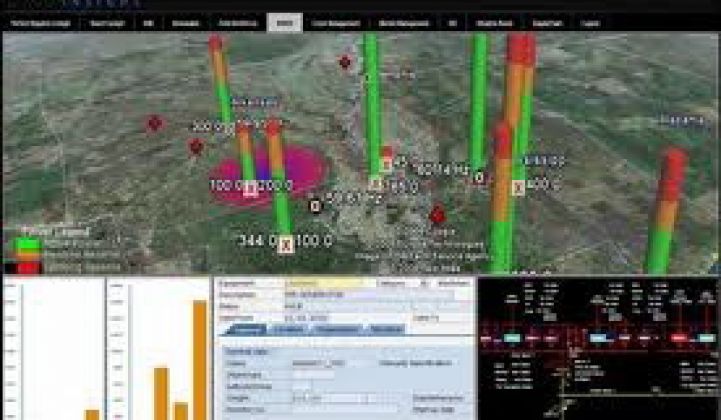Space-Time Insight, a geospatial data analysis startup with customers including Florida Power & Light, San Diego Gas & Electric, California ISO and Cisco Systems (Nasdaq:CSCO), has raised a $14 million Series B round of funding. Chalk up another vote of confidence in the burgeoning world of geospatial information systems (GIS) for utilities and the smart grid -- in other words, making the flood of smart grid data fit into some sort of mapping system to help make sense of it all.
New investors EnerTech Capital, Novus Energy Partners, and ClearSky Power & Technology Fund joined existing investors Opus Capital Ventures and Start Up Farms International (SUFI), in the new round. The Fremont, Calif.-based startup, founded in 2007, raised a Series A round in 2009 from Opus Capital, and while the parties didn’t disclose the dollar amount, one source pegged it at $2 million.
Space-Time Insight crunches loads of real-time data and maps it to geospatial models to help utilities make sense of it all. It has gotten a lot of press for its mapping tools, such as the huge mapping displays that power the California ISO grid operator's new control center.
In January, it launched a “situational intelligence suite” of products, starting with a smart meter intelligence business application, meant to plug directly into utility deployments en masse. It’s the first in what’s intended to be a string of out-of-the-box systems to take utility asset management, smart grid and renewable power integration data and map it out on screen, in near-real time.
It has also partnered with big data company EMC to analyze data pertaining to "non-technical losses" (i.e., energy theft) in power systems. Space-Time Insight is working with EMC Greenplum -- the same platform that Silver Spring Networks recently announced it was working with to manage smart grid data -- as well as SAP HANA, and IBM, OSIsoft, Accenture and Oracle on the massive data integration needs that today’s smart meter deployments have brought to utilities.
Steve Ehrlich, vice president of marketing, spoke to Greentech Media in January, when he differentiated the company from the masses of other GIS vendors by saying, “what those systems generally do not do, or do in a simple way, is integrate the data from multiple systems. Their ability to display analytics based on customer information, weather, and real-time grid information, is really non-existent.”
Managing the floods of data from new smart grid technologies is going to be a challenge. Network management system offerings trying to help manage it include SK Telecom’s GridMaven U.S. subsidiary, Cisco’s field area network and network management system products, startup Proximetry’s cloud-based network management platform and the launch of a meter data analytics suite from meter data management provider (and Siemens acquisition) eMeter.
Space-Time isn’t seeking to replace these types of platforms, but rather to augment them, Ehrlich said, particularly in the geospatial and visual analytics department. “Their analytics are fine, but they don’t have any geospatial capabilities,” he said of today’s smart meter management systems. “Their options are build it, license it, or partner. That’s kind of where we fit in.”
Space-Time is also a listed partner of Cisco’s smart grid ecosystem. While Ehrlich wouldn’t say much about how the two work together, he did confirm that a software demo that Cisco CEO John Chambers conducted for an audience in September was using some of the startup’s technology -- a fact that emerged in comparing the likeness between the geospatial software Chambers showed on stage and the system Ehrlich demonstrated in an online presentation.
Space-Time has some roots in the big data world: its CEO, Robert Schilling, is a former senior vice president and GM of SAP North America, and the company was formed by Oracle vets, said Ehrlich. One of the reasons the startup chose smart metering as its first application is because utility customers are struggling with that area of operations, he noted.
“The primary focus of our customers has been revenue protection, and on making sure that customers are satisfied and happy with the meters,” Ehrlich noted. While today’s smart meters are beginning to turn on additional features like outage detection, remote connect-disconnect and voltage-sensing capabilities, they’ve also seen some problems in delivering accurate bills to customers.
Looking at the next set of applications on offer, utilities “see operational benefits by getting more people to work together,” he said. “What our software does for them is allow them to get up and running in a matter of weeks.” Renewable power integration could be one particularly interesting field, given how hard it’s going to be for utilities in solar and wind power-rich states like California and Texas to manage all of that on-again, off-again intermittent power.
Space-Time Insight saw about 300 percent revenue growth last year, Ehrlich said.



